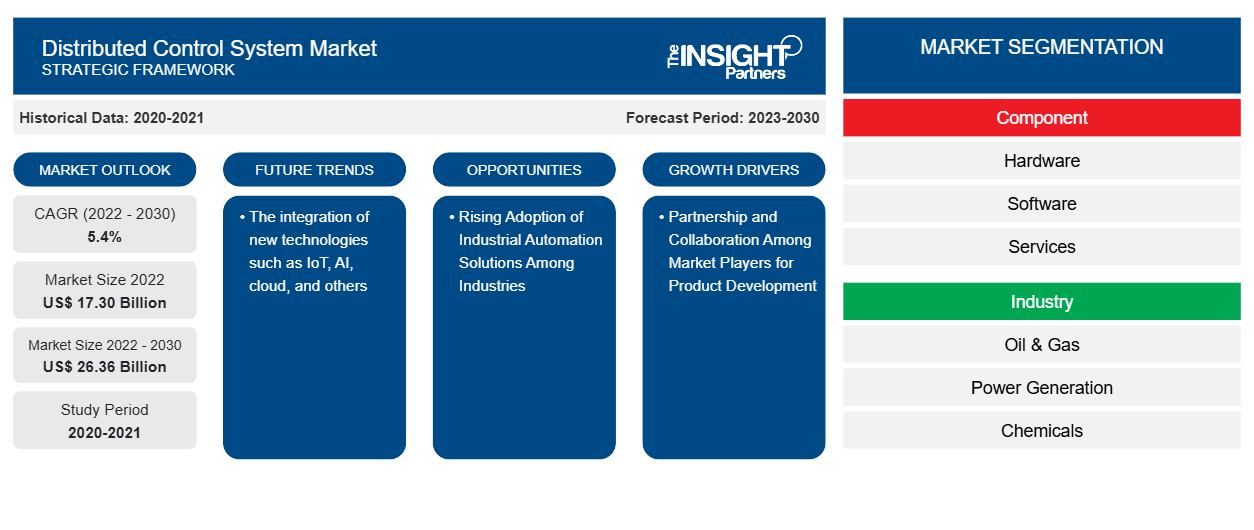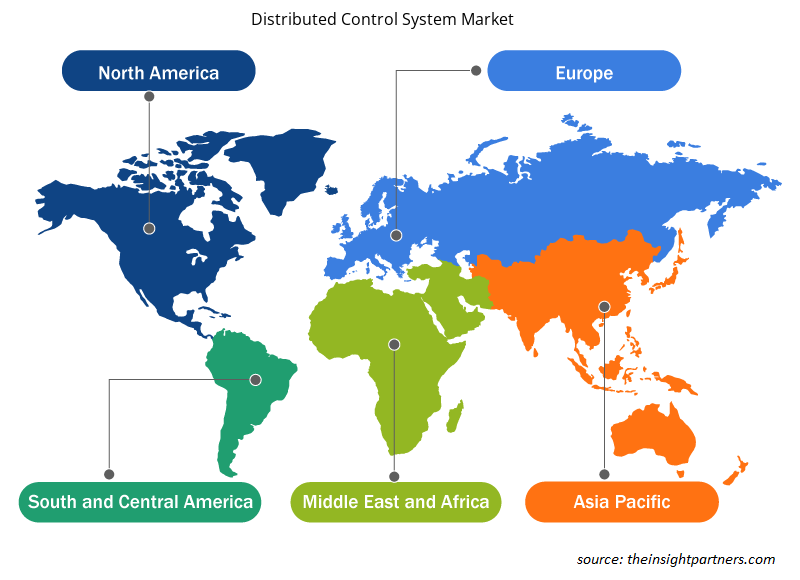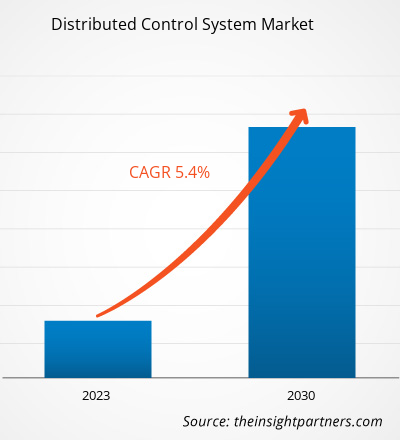The distributed control system market size is projected to reach US$ 26.36 billion by 2030 from US$ 17.30 billion in 2022. The market is expected to register a CAGR of 5.4% during 2022–2030. The integration of new technologies such as IoT, AI, cloud, and others is likely to remain a key trend in the market.
Distributed Control System Market Analysis
Rising adoption of industrial automation solutions among industries and the growing power & energy sector are driving the market. The market is anticipated to grow during the forecast period due to the construction of new manufacturing facilities. Moreover, partnerships and collaboration among market players for product development and architectural development in DCS are creating lucrative opportunities for the market.
Distributed Control System Market Overview
A distributed control system, or DCS, is a computerized system consisting of sensors, controllers, and associated computers that are distributed throughout a plant. Each of these pieces serves a specific function, such as data acquisition, process control, data storage, and graphical display. These various pieces communicate with a central computer via the plant's local area network (LAN), also known as a control network.
The DCS automates industrial equipment used in continuous and batch processes while reducing human and environmental risks. The systems are used in a variety of industries, including mining extraction, chemical manufacturing plants, transportation and processing, electric power production, water and wastewater treatment, and pharmaceutical processing facilities.
Customize This Report To Suit Your Requirement
You will get customization on any report - free of charge - including parts of this report, or country-level analysis, Excel Data pack, as well as avail great offers and discounts for start-ups & universities
Distributed Control System Market: Strategic Insights

- Get Top Key Market Trends of this report.This FREE sample will include data analysis, ranging from market trends to estimates and forecasts.
You will get customization on any report - free of charge - including parts of this report, or country-level analysis, Excel Data pack, as well as avail great offers and discounts for start-ups & universities
Distributed Control System Market: Strategic Insights

- Get Top Key Market Trends of this report.This FREE sample will include data analysis, ranging from market trends to estimates and forecasts.
Distributed Control System Market Drivers and Opportunities
Rising Adoption of Industrial Automation Solutions Among Industries to Favor the Market
Industrial automation is widely defined as the use of hardware and components to automate systems in industrial or manufacturing environments. Companies are launching a variety of programs to encourage the adoption of industrial automation. For instance, in September 2023, Rockwell Automation collaborated with BIC to drive digital transformation and efficiency using the Plex manufacturing execution system (MES). Such initiatives by corporations will drive the growth of the distributed control system market. In addition, the oil and gas, petrochemical, and pharmaceutical industries are expanding rapidly. Technological advancements in these industrial verticals are also high due to the existence of technologically advanced companies, combined with increased government spending in R&D operations.
Partnership and Collaboration Among Market Players for Product Development
Many sectors around the world have expanded dramatically. There is an increasing number of automation firms that specialize in operating ICT sectors around the world. For example, in October 2023, Vention, the Quebec-based business that developed the only fully integrated manufacturing automation platform (MAP), announced a $15 million investment from the Fonds de solidarité FTQ. Vention's robust growth continues with the assistance of its partners as it pursues its objective to democratize industrial automation, enhancing manufacturing enterprises' productivity and competitiveness. In addition, companies' discoveries and improvements have increased the usage of advanced technology. For instance, in August 2023, ANYbotics increased its footprint in Canada by selecting MicroWatt Controls as a reseller partner. MicroWatt Controls, based in Calgary, has extended its inspection robot deployment in the country's oil and gas, chemical, energy, and mining sectors. The ongoing development of process industries is expected to generate demand for distributed control systems in the Canadian market.
Distributed Control System Market Report Segmentation Analysis
Key segments that contributed to the derivation of the distributed control system market analysis are component and industry.
- Based on components, the distributed control system market is divided into hardware, software, and services. The software segment held a larger market share in 2022.
- based on industry, the market is divided into oil & gas, power generation, chemicals, food & beverages, pharmaceuticals, and others. The oil & gas segment held a larger market share in 2022.
Distributed Control System Market Share Analysis by Geography
The geographic scope of the distributed control system market report is mainly divided into five regions: North America, Asia Pacific, Europe, Middle East & Africa, and South & Central America.
The market in Europe is projected to expand during the forecast period due to the expanding automotive industry. Italian government supports the automotive industry heavily. For instance, in December 2023, according to the trade union, the Italian government had ~US$ 6.5 billion available to support its automotive industry. In addition, in July 2023, Fiat parent Stellantis and the Italian government agreed to aim to increase annual automotive production in Italy to one million units, reversing a downward trend seen in recent years. The growth in these industries positively impacted the industrial control systems. Thus, the demand for DCS is growing among the automotive sectors.
Distributed Control System Market Regional Insights
The regional trends and factors influencing the Distributed Control System Market throughout the forecast period have been thoroughly explained by the analysts at The Insight Partners. This section also discusses Distributed Control System Market segments and geography across North America, Europe, Asia Pacific, Middle East and Africa, and South and Central America.

- Get the Regional Specific Data for Distributed Control System Market
Distributed Control System Market Report Scope
| Report Attribute | Details |
|---|---|
| Market size in 2022 | US$ 17.30 Billion |
| Market Size by 2030 | US$ 26.36 Billion |
| Global CAGR (2022 - 2030) | 5.4% |
| Historical Data | 2020-2021 |
| Forecast period | 2023-2030 |
| Segments Covered |
By Component
|
| Regions and Countries Covered | North America
|
| Market leaders and key company profiles |
Distributed Control System Market Players Density: Understanding Its Impact on Business Dynamics
The Distributed Control System Market is growing rapidly, driven by increasing end-user demand due to factors such as evolving consumer preferences, technological advancements, and greater awareness of the product's benefits. As demand rises, businesses are expanding their offerings, innovating to meet consumer needs, and capitalizing on emerging trends, which further fuels market growth.
Market players density refers to the distribution of firms or companies operating within a particular market or industry. It indicates how many competitors (market players) are present in a given market space relative to its size or total market value.
Major Companies operating in the Distributed Control System Market are:
- Honeywell International Inc
- General Electric Co
- ABB Ltd
- Yokogawa Electric Corp
- Toshiba Corp
- Siemens AG
Disclaimer: The companies listed above are not ranked in any particular order.

- Get the Distributed Control System Market top key players overview
Distributed Control System Market News and Recent Developments
The distributed control system market is evaluated by gathering qualitative and quantitative data post primary and secondary research, which includes important corporate publications, association data, and databases. A few of the developments in the distributed control system market are listed below:
- ABB unveiled the latest version of the ABB Ability Symphony Plus distributed control system DCS to assist digital transformation in the power generation and water industries. The most recent version of Symphony Plus will enhance clients' digital journeys by providing streamlined and secure OPC UA1 connectivity to the Edge and Cloud without interfering with key control and automation capabilities. (Source: ABB Ltd, Company Website, February 2023)
Distributed Control System Market Report Coverage and Deliverables
The “Distributed Control System Market Size and Forecast (2020–2030)” report provides a detailed analysis of the market covering below areas:
- Distributed control system market size and forecast at global, regional, and country levels for all the key market segments covered under the scope
- Distributed control system market trends as well as market dynamics such as drivers, restraints, and key opportunities
- Detailed PEST/Porter’s Five Forces and SWOT analysis
- Distributed control system market analysis covering key market trends, global and regional framework, major players, regulations, and recent market developments
- Industry landscape and competition analysis covering market concentration, heat map analysis, prominent players, and recent developments for the distributed control system market
- Detailed company profiles
Frequently Asked Questions
Which are the leading players operating in the distributed control system market?
The key players holding majority shares in the global distributed control system market are Honeywell International Inc, General Electric Co, ABB Ltd, Yokogawa Electric Corp, Toshiba Corp, Siemens AG, Emerson Electric Co, NovaTech LLC, Schneider Electric SE, and Rockwell Automation Inc.
What would be the estimated value of the distributed control system market by 2030?
The global distributed control system market is expected to reach US$ 26.36 billion by 2030.
What is the expected CAGR of the distributed control system market?
The global distributed control system market is estimated to register a CAGR of 5.4% during the forecast period 2022–2030.
What are the future trends of the distributed control system market?
The integration of new technologies such as IoT, AI, cloud, and others to play a significant role in the global distributed control system market in the coming years.
Which region dominated the distributed control system market in 2022?
Asia Pacific dominated the distributed control system market in 2022.
What are the driving factors impacting the distributed control system market?
Rising adoption of industrial automation solutions among industries are the major factors that propel the global distributed control system market.
- Historical Analysis (2 Years), Base Year, Forecast (7 Years) with CAGR
- PEST and SWOT Analysis
- Market Size Value / Volume - Global, Regional, Country
- Industry and Competitive Landscape
- Excel Dataset
Testimonials
Reason to Buy
- Informed Decision-Making
- Understanding Market Dynamics
- Competitive Analysis
- Identifying Emerging Markets
- Customer Insights
- Market Forecasts
- Risk Mitigation
- Boosting Operational Efficiency
- Strategic Planning
- Investment Justification
- Tracking Industry Innovations
- Aligning with Regulatory Trends
Yes! We provide a free sample of the report, which includes Report Scope (Table of Contents), report structure, and selected insights to help you assess the value of the full report. Please click on the "Download Sample" button or contact us to receive your copy.
Absolutely — analyst assistance is part of the package. You can connect with our analyst post-purchase to clarify report insights, methodology or discuss how the findings apply to your business needs.
Once your order is successfully placed, you will receive a confirmation email along with your invoice.
• For published reports: You’ll receive access to the report within 4–6 working hours via a secured email sent to your email.
• For upcoming reports: Your order will be recorded as a pre-booking. Our team will share the estimated release date and keep you informed of any updates. As soon as the report is published, it will be delivered to your registered email.
We offer customization options to align the report with your specific objectives. Whether you need deeper insights into a particular region, industry segment, competitor analysis, or data cut, our research team can tailor the report accordingly. Please share your requirements with us, and we’ll be happy to provide a customized proposal or scope.
The report is available in either PDF format or as an Excel dataset, depending on the license you choose.
The PDF version provides the full analysis and visuals in a ready-to-read format. The Excel dataset includes all underlying data tables for easy manipulation and further analysis.
Please review the license options at checkout or contact us to confirm which formats are included with your purchase.
Our payment process is fully secure and PCI-DSS compliant.
We use trusted and encrypted payment gateways to ensure that all transactions are protected with industry-standard SSL encryption. Your payment details are never stored on our servers and are handled securely by certified third-party processors.
You can make your purchase with confidence, knowing your personal and financial information is safe with us.
Yes, we do offer special pricing for bulk purchases.
If you're interested in purchasing multiple reports, we’re happy to provide a customized bundle offer or volume-based discount tailored to your needs. Please contact our sales team with the list of reports you’re considering, and we’ll share a personalized quote.
Yes, absolutely.
Our team is available to help you make an informed decision. Whether you have questions about the report’s scope, methodology, customization options, or which license suits you best, we’re here to assist. Please reach out to us at sales@theinsightpartners.com, and one of our representatives will get in touch promptly.
Yes, a billing invoice will be automatically generated and sent to your registered email upon successful completion of your purchase.
If you need the invoice in a specific format or require additional details (such as company name, GST, or VAT information), feel free to contact us, and we’ll be happy to assist.
Yes, certainly.
If you encounter any difficulties accessing or receiving your report, our support team is ready to assist you. Simply reach out to us via email or live chat with your order information, and we’ll ensure the issue is resolved quickly so you can access your report without interruption.















The List of Companies- Distributed Control System Market
- Honeywell International Inc
- General Electric Co
- ABB Ltd
- Yokogawa Electric Corp
- Toshiba Corp
- Siemens AG
- Emerson Electric Co
- NovaTech LLC
- Schneider Electric SE
- Rockwell Automation Inc






 Get Free Sample For
Get Free Sample For